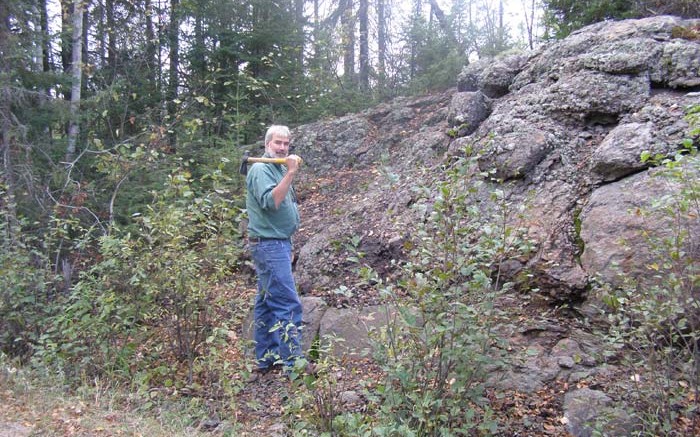VANCOUVER — It’s been a long road for junior Duluth Metals (TSX: DM; US-OTC: DULMF) on the northern edge of Minnesota’s prolific Iron Range, but it looks like development at the company’s Twin Metals joint venture with Antofagasta (LSE: ANTO; US-OTC: ANFGY) could pass a few more milestones in the coming months.
The companies are set to release a prefeasibility study (PFS) based on a large-scale copper–nickel–platinum–palladium–gold resource in July — the first updated study since a preliminary economic assessment (PEA) in 2008 — which will outline a 50,000-tonne-per-day underground mine.
Duluth has also undergone a management change as it approaches possible development. Former chief operating officer Kelly Osborne — who worked as a senior vice-president of underground operations for Freeport-McMoRan Copper & Gold (NYSE: FCX) — stepped in as Duluth’s president and CEO on May 12.
Prior to the changeover, outgoing president Vern Baker sat down with The Northern Miner to discuss his past four years with the company, and the Twin Metals project. (Baker will continue to serve on the Twin Metals technical committee.)
During Baker’s tenure Twin Metals grew as an asset, with the project now hosting measured and indicated resources across four deposits, namely: Maturi, Maturi Southwest, Birch Lake and Spruce Road. Baker says that any mining operation would begin with Maturi, which he calls the “heart” of the story.
“The original PEA in 2008 was done on a much smaller footprint. We now have four geographically distinct resources. Around six years ago was right when the capital acceleration started up throughout the industry, but for us the key issue is that we think it’ll make a great mine.”
He cautions, however, that Twin Metals’ development costs could be above US$2 billion. “We have good rock, good scale, consistency — and for a copper mine, we definitely have the grade. Obviously Antofagasta is a big company that looks at things differently, but they are a great partner.”
A February resource update found that Maturi has 268 million measured tonnes grading 0.63% copper, 0.2% nickel, 0.11 gram platinum per tonne, 0.28 gram palladium per tonne and 0.06 gram gold per tonne. Indicated resources tack on 702 million tonnes of 0.58% copper, 0.19% nickel, 0.14 gram platinum, 0.31 gram palladium and 0.06 gram gold. Updated inferred resources total 510 million tonnes grading 0.51% copper, 0.17% nickel, 0.11 gram platinum, 0.26 gram palladium and 0.06 gram gold.
The newest resource addition is the Maturi Southwest satellite, which hosts 93 million indicated tonnes of 0.48% copper, 0.17% nickel, 0.06 gram platinum and 0.25 gram palladium; as well as 29 million inferred tonnes at 0.43% copper, 0.15% nickel, 0.06 gram platinum and 0.25 gram palladium.
Birch Lake has slightly higher precious-metal credits, and adds 91 million indicated tonnes at 0.52% copper, 0.16% nickel, 0.43 gram platinum, 0.2 gram palladium and 0.09 gram gold; and 217 inferred tonnes at 0.46% copper, 0.15% nickel, 0.31 gram platinum, 0.14 gram palladium and 0.09 gram gold.
“We’ve looked at smelting, several hydrometallurgical systems and concentrate shipping. The simplest is the concentrate sales, so we’ve done quite a bit of work on that. It’s one of the keys, since at one point it was considered that it would be tough to make a good concentrate, and metallurgy was a question on a lot people’s minds,” Baker points out, noting that the copper concentrate should average 25%, with nickel credits below penalty levels. “What we’re seeing, however, is that we can make good twin copper and nickel concentrates, and we’re in a beautiful spot with rail and port access.”
Duluth has been caught up in the recent bull run in nickel prices that started earlier this year. The company notes that Twin Metals globally hosts 4.7 billion measured and indicated lb. nickel and 4.2 billion inferred lb. nickel, and that the U.S. only had one nickel project under construction in 2013. A sustained rise in nickel prices would likely impact profit margins at Twin Metals, with Baker saying that upwards of 35% of the mine’s revenue could come from the metal.
Another milestone for Duluth will come within six months of the filing of a bankable feasibility study, when Antofagasta can opt to take another 25% stake in Twin Metals, which would give the Chilean producer a controlling 65% stake in the project. Under the joint venture Antofagasta could exercise the option at Twin Metals’ net present value.
With a sizable resource already in hand and the PFS nearing completion, the next priority will be permitting. This could be tricky because Twin Metals occupies private land, state land and national forest land.
“The biggest challenge there will come from the national forests,” Baker says. “We’ve had consistent dialogue with the authorities and started baseline work in 2007. You think of Minnesota and nobody thinks mining, but there are currently around nine active operations in the region . . . there have been seven major permits given in the past ten years, and by value, Minnesota is the third-largest mining state in the U.S. We’ve got good support from the governor and legislature, since they’re interested in moving the economy forward.”
Duluth had US$8 million in cash in May after closing a private placement in March, when it placed 10.6 million shares at 65¢ per share for gross proceeds of US$6.9 million. The company’s shares, however, have dropped 33% so far this year, and closed at 53¢ at press time. Duluth has 136 million shares outstanding for a $78-million market capitalization. Antofagasta holds a 10% equity stake.


Be the first to comment on "Duluth sees nickel upside at Twin Metals"